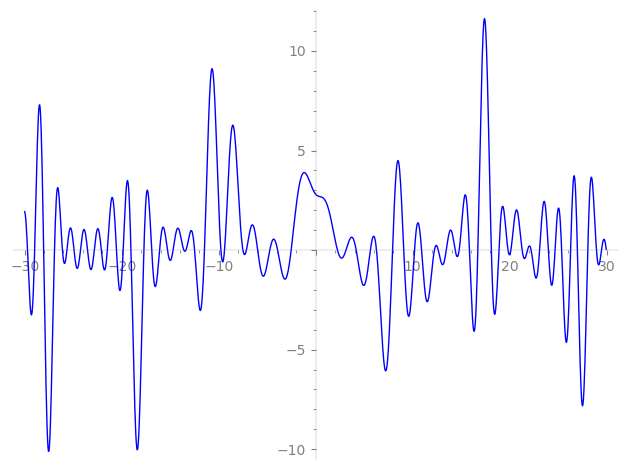| L(s) = 1 | + (1.92 + 1.11i)2-s + 3-s + (1.46 + 2.54i)4-s + (0.701 − 0.404i)5-s + (1.92 + 1.11i)6-s + (−2.09 − 1.61i)7-s + 2.08i·8-s + 9-s + 1.80·10-s + 3.07i·11-s + (1.46 + 2.54i)12-s + (−3.01 + 1.97i)13-s + (−2.24 − 5.43i)14-s + (0.701 − 0.404i)15-s + (0.618 − 1.07i)16-s + (−1.39 − 2.42i)17-s + ⋯ |
| L(s) = 1 | + (1.36 + 0.785i)2-s + 0.577·3-s + (0.734 + 1.27i)4-s + (0.313 − 0.181i)5-s + (0.785 + 0.453i)6-s + (−0.792 − 0.610i)7-s + 0.738i·8-s + 0.333·9-s + 0.569·10-s + 0.927i·11-s + (0.424 + 0.734i)12-s + (−0.836 + 0.548i)13-s + (−0.599 − 1.45i)14-s + (0.181 − 0.104i)15-s + (0.154 − 0.267i)16-s + (−0.339 − 0.588i)17-s + ⋯ |
\[\begin{aligned}\Lambda(s)=\mathstrut & 273 ^{s/2} \, \Gamma_{\C}(s) \, L(s)\cr =\mathstrut & (0.625 - 0.780i)\, \overline{\Lambda}(2-s) \end{aligned}\]
\[\begin{aligned}\Lambda(s)=\mathstrut & 273 ^{s/2} \, \Gamma_{\C}(s+1/2) \, L(s)\cr =\mathstrut & (0.625 - 0.780i)\, \overline{\Lambda}(1-s) \end{aligned}\]
Particular Values
| \(L(1)\) |
\(\approx\) |
\(2.52805 + 1.21326i\) |
| \(L(\frac12)\) |
\(\approx\) |
\(2.52805 + 1.21326i\) |
| \(L(\frac{3}{2})\) |
|
not available |
| \(L(1)\) |
|
not available |
\(L(s) = \displaystyle \prod_{p} F_p(p^{-s})^{-1} \)
| $p$ | $F_p(T)$ |
|---|
| bad | 3 | \( 1 - T \) |
| 7 | \( 1 + (2.09 + 1.61i)T \) |
| 13 | \( 1 + (3.01 - 1.97i)T \) |
| good | 2 | \( 1 + (-1.92 - 1.11i)T + (1 + 1.73i)T^{2} \) |
| 5 | \( 1 + (-0.701 + 0.404i)T + (2.5 - 4.33i)T^{2} \) |
| 11 | \( 1 - 3.07iT - 11T^{2} \) |
| 17 | \( 1 + (1.39 + 2.42i)T + (-8.5 + 14.7i)T^{2} \) |
| 19 | \( 1 + 4.31iT - 19T^{2} \) |
| 23 | \( 1 + (2.47 - 4.28i)T + (-11.5 - 19.9i)T^{2} \) |
| 29 | \( 1 + (2.84 + 4.93i)T + (-14.5 + 25.1i)T^{2} \) |
| 31 | \( 1 + (2.93 + 1.69i)T + (15.5 + 26.8i)T^{2} \) |
| 37 | \( 1 + (-8.42 - 4.86i)T + (18.5 + 32.0i)T^{2} \) |
| 41 | \( 1 + (-8.48 + 4.90i)T + (20.5 - 35.5i)T^{2} \) |
| 43 | \( 1 + (2.85 - 4.93i)T + (-21.5 - 37.2i)T^{2} \) |
| 47 | \( 1 + (-5.31 + 3.06i)T + (23.5 - 40.7i)T^{2} \) |
| 53 | \( 1 + (-2.83 + 4.91i)T + (-26.5 - 45.8i)T^{2} \) |
| 59 | \( 1 + (4.27 - 2.46i)T + (29.5 - 51.0i)T^{2} \) |
| 61 | \( 1 + 3.03T + 61T^{2} \) |
| 67 | \( 1 - 9.92iT - 67T^{2} \) |
| 71 | \( 1 + (7.84 + 4.52i)T + (35.5 + 61.4i)T^{2} \) |
| 73 | \( 1 + (-2.75 - 1.58i)T + (36.5 + 63.2i)T^{2} \) |
| 79 | \( 1 + (-1.13 - 1.97i)T + (-39.5 + 68.4i)T^{2} \) |
| 83 | \( 1 + 1.52iT - 83T^{2} \) |
| 89 | \( 1 + (-2.87 - 1.66i)T + (44.5 + 77.0i)T^{2} \) |
| 97 | \( 1 + (-11.0 - 6.36i)T + (48.5 + 84.0i)T^{2} \) |
| show more | |
| show less | |
\(L(s) = \displaystyle\prod_p \ \prod_{j=1}^{2} (1 - \alpha_{j,p}\, p^{-s})^{-1}\)
Imaginary part of the first few zeros on the critical line
−12.48821847064937052853685149272, −11.47054036988522493974097046903, −9.773458075754042451856487801618, −9.402006949958039951833141005022, −7.50508896395442535030713656849, −7.14573454450916461136186874325, −5.98320141395695467808392042167, −4.73547974248722866076809041447, −3.92744425329664366665875039821, −2.53217799946920522199119659060,
2.24029059950891317268629658653, 3.12212258888688375784651965696, 4.17224473708827762751107753288, 5.63635565769084611734836699197, 6.26435838595210286867632500486, 7.917895031399119009096123877111, 9.072704094622132041867830429990, 10.18224654064074972624864293042, 10.91143743630564348841639535383, 12.23475718528190030610344710243

